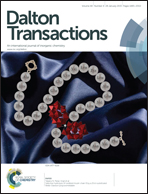Adsorption of uranyl on hydroxylated α-SiO2(001): a first-principle study†
Abstract
The adsorption of [UO2(H2O)5]2+ on a hydroxylated α-SiO2(001) surface was studied by periodic density functional theory (DFT) and ab initio molecular dynamics (AIMD) simulation. The effects of pH, CO2, aqua solution and anionic ligands (OH−, NO3− and Cl−) on the adsorption geometry and stability were investigated. The results show that the adsorption of uranyl on a hydroxylated α-SiO2(001) surface leads to the formation of inner-sphere complexes, in which the bidentate complex at the double deprotonated site is most favored. The binding strengths of bidentate and monodentate complexes at the same site are similar, and they become weaker as the number of protons increases at the adsorption site, indicating an enhancement of the adsorption strength at higher pH values within a certain range. Strong chemical interaction plays an important role in all inner-sphere complexes. The hydrogen bonds are formed between uranyl and the hydroxylated surface in all inner- and outer-sphere complexes. The presence of CO2 weakens the adsorption of uranyl on the surface by forming uranyl carbonate (CO32−, HCO3−) complexes. The effect of the anion ligands depends on their charged state and their concentration in solutions. The explicit treatment of water environment in the models has a slight effect on the adsorption configuration. These results are consistent with the experimental observations.


 Please wait while we load your content...
Please wait while we load your content...